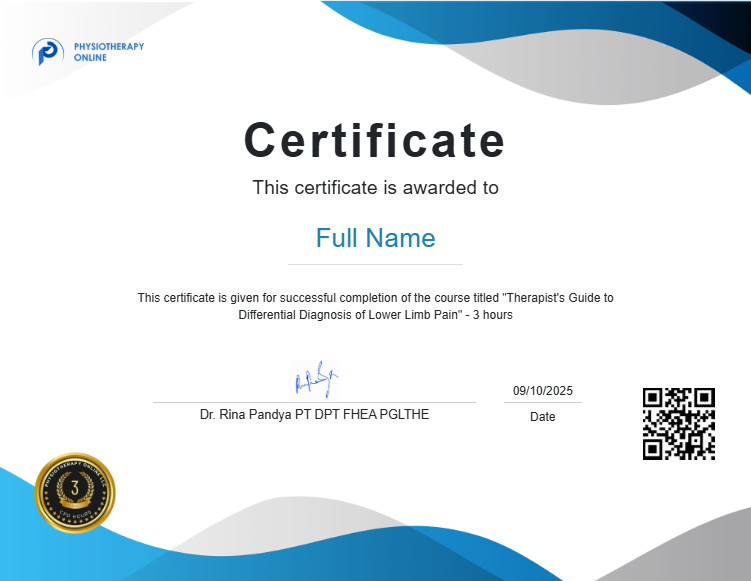About Course
Differential Diagnosis of Lower Limb Pain Aim to
The main focus of this course is to provide skills to assess systemic differential diagnosis of lower limb pain. Identifying the systemic cause and knowledge of referring to the physician or medical emergency services can potentially save precious time, resources and drastically change patient outcomes. This course will equip the clinicians with skills to stop chasing the symptoms and narrow down the source of dysfunction and pain earlier on in the course of therapy.
In addition, this is a concise course designed to be a handy reference guide for clinicians to perform a skilled evaluation, including subjective questioning and history taking, with objective examination with musculoskeletal special tests, and evidence based treatment strategies and understand bilateral lower limb weakness differential diagnosis.
Learning Objective
- Apply the knowledge MSK evaluation strategies for hip knee, ankle-foot joint clinically through identification of musculoskeletal injuries.
- Analyze red flags and yellow flags, referral criteria for the physician
- Differentiate between systemic and musculoskeletal differential diagnosis in order to identify the need for therapy or refer to the physician or emergency services.
- Demonstrate skilled patient interviewing techniques with system review questions for differential diagnosis.
Course Curriculum:
Section 1: Bilateral lower limb weakness differential diagnosis
1 hr : Hip anatomy with clinical applications
Common MSK Diagnosis, with in depth etiology and management of Hip OA + CPG, ITB syndrome, Hip bursitis, Femoroacetabular impingement. Snapping hip syndrome and Piriformis syndrome, groin pain, nerve entrapment in the hip, meralgia paresthetica.
1 hr Systemic DD Assessment with MSK testing and interview questions for systemic DD
Section 2: Knee Pain differential diagnosis
1 hr: Knee anatomy with clinical application:
Common MSK diagnosis with in depth eitiology and management of Patellofemoral pain, Tibial plateau fractures, knee ligament injuries, special tests of the knee with videos
1hr: Systemic DD of knee pain sciatica, Oncologic causes, Urologic causes, infectious and inflammatory causes, GI causes, vascular causes-- special questions to ask under each section.
Section 3:Ankle Foot Pain differential diagnosis
1 hr: Clinical anatomy of ankle and foot. MSK diagnosis of ankle and foot, EBP for ankle foot pain, EBP for kinesiotaping for ankle instability, CPG for lateral ankle sprain (2021),special tests for the ankle joint and ligament testing.
1hr: systemic causes of ankle foot pain - screening for peripheral vascular diseases, neurological causes, identification of red flags, criteria for physician referral.
Who should Enroll
Physiotherapists
Physiotherapy assistants
Orthopedic
Nurses
Credit Hours
3 hours
Recourses
- Lifetime Access to Learning Material
- Downloadable Course Material
- CPD Certificate
- 30 Days Access to Learning Resources
Presenter
RINA PANDYA, PT. DPT, APTA (USA) HCPC (UK),MCSP (UK),FHEA
Rina Pandya, PT, DPT, received her entry level physical therapy degree from the School of Allied Health Sciences Manipal, India and her post professional doctoral degree from the University of Michigan- Flint. Having practiced physical therapy in four countries including India, Oman, the United Kingdom and the United States coupled with administrative experiences as a rehabilitation manager; Dr. Pandya shares an eclectic model of practice that maximizes autonomous care. As an avid believer of lifelong professional learning, Dr. Pandya has taken an extensive number of professional development courses and certifications that allow her to teach contemporary practice to clinicians. Dr. Pandya’s appreciation for evidence-based practice continues following completion of a formal research methods program offered through the Manchester School of Physiotherapy in the United Kingdom. Dr. Pandya’s passion for teaching and learning along with the joy in helping clinicians succeed makes her an apt instructor for this course.
Disclaimer: Our online physiotherapy courses meet the criteria and guidelines for CPD (Continuing Professional Development). The CPD hours indicated on the certificate contribute towards fulfilling professional standards and requirements necessary for CPD audits conducted by the HCPC and AHPRA. These CPD hours are important for maintaining physiotherapy registration and ensuring compliance with CPD audit and Physiotherapy registration renewal processes. Our courses are recognized as valuable continuing education resources across the UK, Australia, New Zealand, and throughout Asia and the Middle East.


